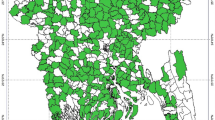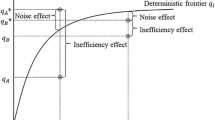Abstract
Rice and shrimp farming are two important economic activities in rural southern Thailand that compete each other in land allocation leading to land use conflicts. Moreover, it can be observed that the conversion of rice fields to shrimp farms is already extended from coastal areas to the inlands. These conversions are making more area be saline which is essential condition for shrimp cultivation but deleterious for rice farming. We are looking at the unidirectional externalities originating from the conversion which brings the productivity of adjacent rice fields further down. This study attempts to quantify the external effects on rice yield and efficiency of rice farming by constructing three models. Model I, we assess the rice yield function by using the multiple linear regression while in Model II, we attempt to delineate the technical efficient frontier of rice farms by using an input oriented non-parametric approach, so called data envelopment analysis. Model III, we probe into the factors influencing technical efficiency scores using the Tobit regression. Database of the study is constituted by primary survey data from 120 rice farms in Songkhla province for the crop year 2004/2005. The 30 out of 120 sample farms have been affected by externality of shrimp farming. The empirical results of all three models show that shrimp farming externalities caused a production drop of 467–515 kg paddy rice per ha and significantly affect the technical efficiency of rice farms. The measures of internalizing this externality are discussed.

Similar content being viewed by others
References
Ali AMS (2006) Rice to shrimp: land use/land cover changes and soil degradation in Southwestern Bangladesh. Land Use Policy 23:421–435
Barbier EB, Cox M (2004) An economic analysis of shrimp farm extension and mangrove conversion in Thailand. Land Econ 80:389–407
Charernjiratragul S, Kiatpathomchai S, Prommee P, Duramae A (2003) A study on economic and social results from reclamation of abandoned shrimp farm areas for agriculture. Research Report (in Thai)
Charnes A, Cooper WW, Lewin AY, Seiford LM (2000) Data envelopment analysis: theory, methodology, and application. Kluwer Academic Publishers, London
Coelli T (1996) A guide to DEAP version 2.1: a data envelopment analysis. Center for Efficiency and Productivity Analysis. Department of Econometrics. University of New England, Armidale
Cooper WW, Seiford LM, Tone K (2006) Introduction to data envelopment analysis and its uses. Springer Science and Business, New York
De Koeijer TJ, Wossink GAA, Struik PC, Renkema JA (2002) Measuring agricultural sustainability in terms of efficiency: the case of Dutch sugar beet growers. J Environ Manage 66:9–17
Greene WH (1995) LIMDEP version 7.0 user’s manual. Econometric Software Inc., New York
Huitric M, Folke C, Kautsky N (2002) Development and government policies of the shrimp farming industry in Thailand in relation to mangrove ecosystems. Ecol Econ 40:441–455
Kantangkul P (2002) Impact of shrimp farming on arable land and re-habilitation of resultant salt affected soils: socio-economic and agricultural economic aspects. Final report, FAO project TCP/THA/8922
Khachathong, S (2004) Some salt tolerant crop cultivation on abandoned shrimp pond area. Master Thesis, Prince of Songkla University, Songkhla (in Thai)
Maddala GS (1999) Limited dependent and qualitative variables in econometrics. Cambridge University Press, New York
MOAC (2004) Thailand rice strategy of the year 2004–2008. Ministry of Agriculture and Cooperatives, Bangkok (in Thai)
MOC (2006) Export statistic of Thailand by commodities in 2001–2006. http://www.moc.go.th/
NESDB (2004) National income and gross domestic product 2003. http://www.nesdb.go.th
Nissapa A, Charernjiratragul S, Boromthanarat S (2002) Institutional and legal implimentations for integrated mangrove-shrimp farming-environmental planning and management in Laem Talumphuk, Pak Phanang District, Nakhon Si Thammarat Province. Songklanakarin J Soc Sci Humanit 8:17–31 (in Thai)
OAE (2005) Agricultural statistics of Thailand 2004, Agricultural Statistic Number 410, Bangkok, Thailand
Paez-Osuna F (2001) The environmental impact of shrimp aquaculture: causes, effects, and mitigating alternatives. Environ Manage 28:131–140
Pongthanapanich T (2005) An optimal corrective tax for Thai shrimp farming. Department of Environmental and Business Economics, IME Working Paper 64/05. University of Southern Denmark
Pongthanapanich T, Roth E (2006) Toward environmental responsibility of Thai shrimp farming through a voluntary management scheme. Department of Environmental and Business Economics, IME Working Paper 70/06. University of Southern Denmark
Pretty J, Brett C, Gee D, Hine R, Mason C, Rayment M, Bijl Gvd, Dobbs T (2001) Policy challenges and priorities for internalizing the externalities of modern agriculture. J Environ Plann Manage 44:263–283
PSU (2005) Land use map of the southern region. GEO-Informatics research center for natural resource and environment. Faculty of Environmental Management, Prince of Songkla University, Songkhla
Sathirathai S, Barbier EB (2001) Valuing mangrove conservation in southern Thailand. Contemp Econ Policy 19:109–122
Thongrak, S (2003) Evolution of Land Uses and Forest Land Uses in Songkhla Lake Basin. Research Report, Thailand Research fund (in Thai)
Thongrak S, Prato T, Chaiyvareesajja S, Kurtz W (1997) Economic and water quality evaluation of intensive shrimp production systems in Thailand. Agric Syst 53:121–141
Towatana P, Voradaj C, Panapitukkul N (2002) Changes in soil properties of abandoned shrimp ponds in southern Thailand. Environ Monit Assess 74:45–65
Weersink A, Wossink A (2005) Lessons from agri-environmental policies in other countries for dealing with salinity in Australia. Aust J Exp Agric 45:1481–1493
Author information
Authors and Affiliations
Corresponding author
Rights and permissions
About this article
Cite this article
Kiatpathomchai, S., Schmitz, P.M., Amjath Babu, T.S. et al. Investigating external effects of shrimp farming on rice farming in southern Thailand: a technical efficiency approach. Paddy Water Environ 6, 319–326 (2008). https://doi.org/10.1007/s10333-008-0130-1
Received:
Accepted:
Published:
Issue Date:
DOI: https://doi.org/10.1007/s10333-008-0130-1




